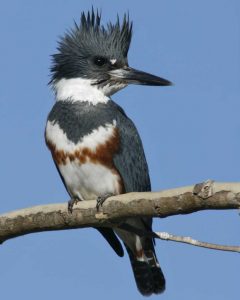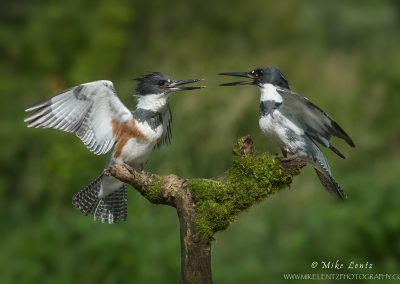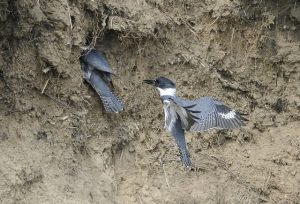
A female Belted Kingfisher perched on a branch. (Retrieved from www.Audubon.org)
The belted kingfisher is a marvelous bird. Their colors, flying maneuvers, and mesmerizing sounds are sure to grab your attention if the Mohawk-like feathers on the top of its head don’t already! Does it not look like this bird just rolled out of bed? Contrary to how they appear, belted kingfishers act with elegance. In addition to Belted Kingfisher, these birds are known by their scientific name Megaceryle alcyon. This named was derived from the Latin words mega, ceryle, and alcedo, meaning great, bird, and kingfisher, respectively (Helm 2010).
Kingfishers are really great birds. Their most obvious features include their long pointed bill, their bright blue and white coloration, and their spiked up hair on top of their head (Cornell Lab 2017). If you have seen a belted kingfisher, you may have noticed that they are medium-sized and differ in feather color. The difference in feather coloration can be explained by dimorphism – when males and females look different (Schablein 2012).

A female (left) and male (right) belted kingfisher in a courtship ritual (taken by Mike Lentz).
Both sexes are short and stalky with slate-blue and white feathers. A blue band of feathers across the chest is present under a white collar separating the blue head. Male and females have a short black and white striped tail, and long wings with white patches on the upper wing. Although male and female belted kingfishers do share some qualities, the male has a white under-body and the female’s feathers are a brighter blue. In addition to a blue band of feathers across the females chest, she also has a band of reddish-brown feathers below, extending above her legs (Cornell Lab 2017). Young birds take on the appearance of both parents, with their chest showing a band of mixed blue and reddish-brown. The crest of blue feathers on top of the adult’s heads is darker in young birds (Arkive 2017).
Belted kingfishers live all across North America, spanning from Alaska to Central America, from the West to East coast (Cornell Lab 2017; What Bird 2017). You are likely to see them at estuaries, streams, lakes, rivers, and ponds where they prey on fish and other aquatic animals. You may even see them along coastal regions as they migrate down south for the Winter towards the Southern United States and Central America (Arkive 2017). Belted Kingfishers breed in North America within Alaska, Canada, and the Northern United States over quite a large range – 10.3 million square kilometers to be exact (What Bird 2017)!

The distribution of the Belted Kingfisher during the Summer, the Winter, and year-round (from the Cornell Lab of Ornithology).
Where ever a kingfisher lives within this range, they will create a burrow to serve as their nest using their feet with fused middle toes, and bill (Schablein 2012). Along the water body where the birds fish, they search for steep, exposed dirt banks to build their nest in. Both male and female kingfishers work at constructing a burrow or tunnel nest usually in a higher region of a steep bank to provide protection against flooding and predation (Arkive 2017; Cornell Lab 2017). The entrance of the burrows is also angled steeply upwards towards the nest to prevent flooding. Belted kingfishers use human-made gravel pits to nest in as well.

A male and female belted kingfisher entering a burrow nest within a dirt bank ( from http://farm4.staticflickr.com).
They vigorously defend their nests from other kingfishers but have been seen to share the tunnel to their nest with swallows, who create their own nests in extensions of the tunnel (What Bird 2017)! Typically, belted kingfishers will produce five to eight eggs per clutch once a year, which hatch into little blind naked kingfishers after 22 to 24 days (Cornell Lab 2017). Both the male and female incubate the eggs.
In addition to requiring dirt or sandbanks to live, belted kingfishers also need a region where the water is clear enough for them to see fish, and where riparian vegetation exists, that is where plants grow beside the water. Belted kingfishers use extending branches or wood posts to perch on so they can locate their prey in the water below (Schablein 2012).
These birds primarily eat small fish near the surface or in shallow water, but will also consume crayfish, insects and snails, amphibians and reptiles, young birds and small mammals, and even small berries (Celestine 2014; What Bird 2017). Once they have seen their prey Kingfishers will directly dive for prey from their perch or will hover above the water to heights reaching 15 meters, and dive down to catch their prey. (Arkive 2017; Celestine 2014). Belted kingfishers dive head first straight down or spiraling, catching their prey with their bill (Schablein 2012). If their prey wasn’t speared on impact, kingfishers will return to their perch with the fish in their bill by swimming up and out of the water. Once at their perch the bird will either pierce the fish with its bill or strike it against their perch until it is dead or unconscious (Celestine 2014). To eat the fish, kingfishers swallow it head first, sometimes after a victory toss of the fish in the air. To see a belted kingfisher in predatory action, check out the video below!
A female belted kingfisher fishing from her perch and striking her prey repeatedly before eating it (recorded by Tommie Gunther).
When not perched searching for prey or nesting at night, belted kingfishers fly over their territory which can reach up to 300 to 500 meters (Schablein 2012). They fly fast searching for food or to ward off potential threats. If they identify a threat, such as another kingfisher in their territory or a predator they may fly back to their perch and extend their body up and down, or fly back and forth along the water body. When threatened in flight belted kingfishers make a distinct rattling call in hopes of warding off the intruder (Celestine 2014; Cornell Lab 2017). They can rattle while perched as well. Press play on the audio below to hear a belted kingfisher rattle!
A short rattling call made by a Belted kingfisher.
The belted kingfishers have other calls as well, making up at least six different vocalizations in total (Schablein 2012). While the rattle is typically used to defend territory, if seriously threatened they may scream and raised their expanded wings to their head. Belted kingfishers calls are also used to identify themselves; each bird’s call differs slightly(Celestine 2014). When a male is trying to get a female’s attention during his attempt to mate she may make a warbling call (Arkive 2017). Nestlings can also make a rattle, but it is less harsh and is identified as a begging call (Celestine 2014).

A male belted kingfisher in flight (from http://1.bp.blogspot.com).
If you can imagine, about 1.7 million belted kingfishers exist within North America. Although this number is high, the number of belted kingfishers drops by about 1.5% each year, placing them as Least Concern under the IUCN Redlist (Cornell Lab 2017). Although hunting of these birds has ceased, habitat disturbance and toxic contamination may be the reason for the concern of conservation of this species.
If you want to learn more about how Belted Kingfishers are affected by toxins and pollutants check out my next blog post!
References:
Arkive. Belted kingfisher (Megaceryle alcyon) [Internet] [cited 2017 Oct 28]. Available from: http://www.arkive.org/belted-kingfisher/megaceryle-alcyon/
Celestine R. 2014. Megaceryle alcyon (Belted Kingfisher). UWI: The Online Guide to the Animals of Trinidad and Tobago [Internet] [cited 2017 Oct 28]. Available from: https://sta.uwi.edu/fst/lifesciences/documents/Megaceryle_alcyon.pdf
Helm C. 2010. The Helm dictionary of scientific bird names [Internet]. London: A&C Black Publishers Ltd; [cited 2017 Oct 29]. Available from: https://ia601308.us.archive.org/34/items/Helm_Dictionary_of_Scientific_Bird_Names_by_James_A._Jobling/Helm_Dictionary_of_Scientific_Bird_Names_by_James_A._Jobling.pdf
Schablein J. 2012. Megaceryle alcyon. Animal Diversity Web [Internet] [cited 2017 Oct 29]. Available from: http://animaldiversity.org/accounts/Megaceryle_alcyon/
The Cornell Lab of Ornithology: All About Birds. Belted Kingfisher [Internet] [cited 2017 Oct 29]. Available from: https://www.allaboutbirds.org/guide/Belted_Kingfisher/lifehistory
What Bird: Field Guide to Birds of North America. Belted Kingfisher [Internet] [Cited 2017 October 29]. Available from: http://identify.whatbird.com/obj/61/behavior/Belted_Kingfisher.aspx
Awesome post Kaitlin! I love these charismatic birds with their cute hair-do! I had no idea they built these tunnels and burrows in dirt banks. Do you know if the burrows decrease predation for these birds? I imagine these tunnels would decrease their exposure compared to a more traditional nesting site. I also enjoyed the video clip you included to show the Kingfishers in predatory action. They are definitely amazing fishermen!
Hey Chanelle! Thank you so much for the feedback. The burrows used by Belted Kingfishers definitely protect them from predation in addition to flooding. From what I have found online it does appear that burrow nests are more effective in protecting eggs and young from predators than other nest types.An overview of nest types can be found at the Golden Gate Audubon Society website. Here it mentions that burrow nests are very effective in protecting from predation. Although they are great at protecting from predators, it turns out that Belted Kingfishers are very susceptible to human activity and excavation. The video was actually my favorite component of the post; it’s so cool how they fish!
I really enjoyed this blog post! It would be so cool to catch one of these birds in the act of hunting! It’s also interesting that the females are brighter than the males and have more colouration. Did you read anything about their mating strategies which could explain why the females have evolved this way?
Hey Paige!
Thank you for the feedback! There has yet to be a definite explanation for the different coloration between male and female belted kingfishers. However, a couple of possibilities have been proposed. It is likely that the brighter females with a rufous breast band allow males to detect them. During migration some males remain in their territories in the north to avoid loosing their habitat. Yet, females always migrate to the south in winter. It is believed that upon the return of the females, their bright colouration signals to the males that a female is present. This allows males to determine whether an intruding male or possible female mate is within their territory.
Another alternate explanation is that the bright and rufous colouration is the result of different hormone levels in the females body. During the breeding season females are more aggressive and territorial than males, resulting in higher testosterone levels. It may be that these high testosterone levels are associated with how pigments are incorporated into the females feathers. All of the is explained on the Cornell Lab of Ornithology website!
I also never knew that these birds use burrows for their nests, super cool! When researching the conservation of this species, did it mention anything about rising water levels (due to dams, urbanization, flooding, etc) affecting the populations size? and if so, are the presence of these nests taken into consideration in aquatic ecosystem management?
-Brianna
Hi Brianna! Those are great questions!
I have not been able to find anything regarding increasing water levels affecting belted kingfisher populations. These birds do dig their nests so that they have an incline up into the actual nesting area. It is believed that this is done to prevent flooding of the nest. I would think that if water levels did get high enough to barricade the birds in their nest they may be able to dig them selves out. Yet, I don’t think flooding occurs frequently enough to affect bird populations. However, if it does, and if aquatic ecosystem management is aware of it, I would hope that they would take the flooding of bird nests into account in future projects.